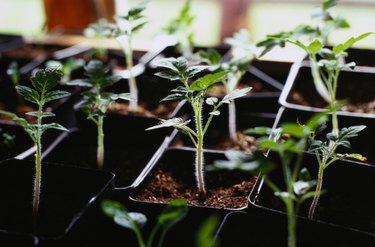
Abnormal color changes on your tomato plant (Solanum lycopersicum, USDA zones 10-11) should throw up a warning flag for you. If you notice the tomato plant leaves turning yellow after you have transplanted the seedlings, you should consider what might have gone wrong during the planting process. If it happens soon after transplanting, it usually is a problem with the transplant rather than a new problem caused in the garden.
Lack of Nitrogen
Video of the Day
When grown in potting soil mixes and pots that have been fertilized carefully, tomato plants aren't likely to lack for nitrogen. However, when they are moved from that controlled location into the garden and you didn't test the soil beforehand, you may be planting them unwittingly in an area with low nitrogen, which can cause yellow leaves on tomato plants.
Video of the Day
It's not too late to test the soil in the garden bed to determine what, if any, nutrients are lacking. Meanwhile, adding a layer of well-decomposed compost and manure or nitrogen fertilizer should help correct the problem. Always water well after applying fertilizer to protect the plants' roots.
Leaf Scorching and Yellow Tomato Leaves
If a plant isn't getting enough water, especially if the weather has turned hot, the leaves may become scorched and turn yellow. This is a common problem in transplanted plants because the roots are not yet firmly established in the garden soil and drawing water the way they do in a more mature plant.
Water regularly to ensure that your tomatoes get enough water at all times for a few weeks after they are transplanted. Keep the soil evenly moist, but don't overwater, as this also can cause problems. Accidentally damaging the roots during transplanting may also result in a failure to absorb water from the soil. Plant tomatoes deep, with only the top two to four sets of leaves above the soil; new roots will develop along the buried stem and branches, which helps avoid moisture loss and transplant shock.
Early Blight and Tomatoes
Another cause of yellow leaves on tomato plants is early blight. This fungus is spread through many different means, and it is important to keep an eye out for it. If it shows up on transplanted tomato plants it is likely that the blight had been a problem there previously.
The best way to avoid this problem is to rotate where you plant your tomatoes frequently. Crop rotation and destroying plants as soon as you notice blight help prevent large outbreaks.
Insect Damage on Tomato Leaves
If you transplant tomatoes into an area where insects already are a problem, they will quickly attack the new food source that you have introduced into their area. Many different insects cause yellowing of the leaves as they attack plants.
Psyllids, also known as jumping plantlice, and aphids are sap-sucking insects that attack tomato leaves and will cause the leaves to turn yellow. Look on the bottom of the leaves to see if insects are present and causing the problems. Other insects causing leaf yellowing in transplants include spider mites and whiteflies.
Knock off pests with a blast of water from the hose. If it is a severe infestation, consider using an insecticidal soap or neem oil spray. Because tomatoes are self-pollinating, you can spray the plants early in the morning and cover with a bedsheet for the day to keep honeybees and other beneficial pollinators away from the freshly-applied insecticide. Neem oil dissipates in 45 minutes to an hour, so it won't affect bees by afternoon or the next day.